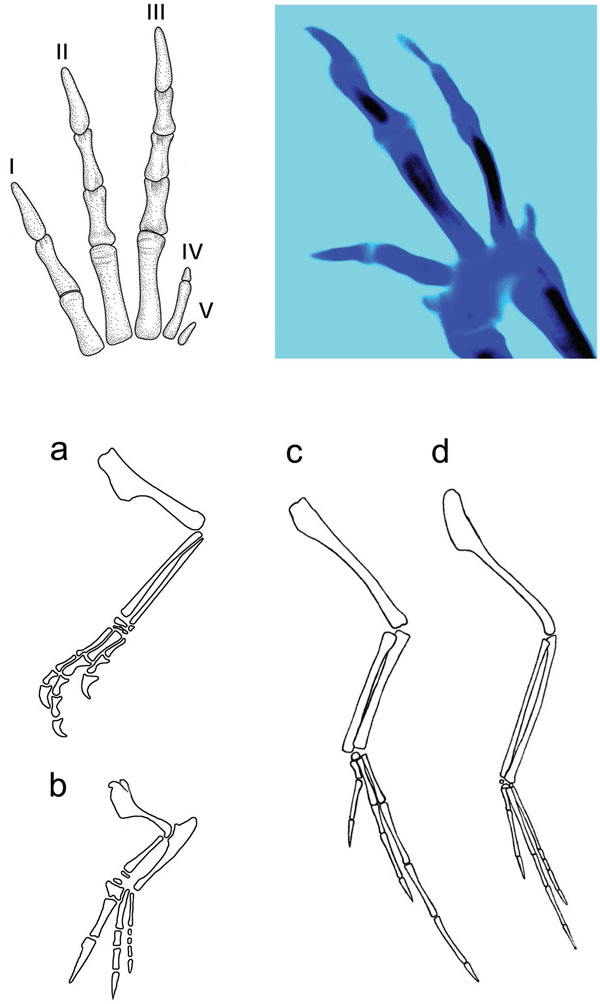Fig. (7) Problematic transitions. Coelurosaurs are included in many cladograms, based on the a priori assumption they are closest to birds, but an evolutionary transition from so-called coelurosaurs to birds is no simple feat, morphologically or embryologically. Above, right, the hand of an ostrich embryo at day 14-15 showing well-developed condensations for digits II-III-IV, with greatly reduced, vestigial condensations for digits I and V. This is the typical amniote pattern of symmetrical reduction. Yet, the hand of the Triassic basal saurischian Herrerasaurus, upper left, (possible theropod) as with other Triassic forms, exhibits the typical theropod pattern of asymmetrical reduction, producing a hand with digits I-II-III, a grasping raking hand. In Herrerasaurus the greatly reduced and vestigial digits IV and V are clearly present. In attempts to accommodate the cladogram those supporting the current orthodoxy propose a homeotic frameshift, but this almost takes on the form of a “Deus ex Machina” and would have occurred with no obvious selective advantage, somewhere between “Allosaurus and birds.” Too, why would there have been a frameshift, if “birds are dinosaurs” and would have already possessed the theropod hand at their origin? Below, forelimbs of (a) Triassic herrerasaurid, and (b) compsognatid coelurosaur Sinosauropteryx, compared to, right, Scansoriopteryx (c) and Archaeopteryx (d). Such a transition would represent an abrogation of Dollo’s rule, involving the re-elongation of already fore-shortened forelimbs, to half the length of the hindlimbs, with totally different proportions and stubby hands. Other problematic areas include the pelvis where many of the basal avian taxa, such as the scansoriopterids and anchiornithids have a partially closed acetabulum and lack a supra-acetabular crest. Even Caudipteryx and Archaeopteryx do not possess a supra-acetabular crest, and thus birds would have to first lose the dinosaurian pelvic characters associated with obligately bipedal posture and then re-evolve this complex feature. The pelvis of scansoriopterids appears like that of basal archosaurs, and the pubis is non-dinosaurian. Left, from Feduccia, adapted from Sereno PC. J Vert Paleo; 1990; 180: 21-51; upper right, modified from Feduccia [55]. Lower images: Left, a herrerasaurid (after Sanjuansaurus, adapted from Alcobar OA. Zoo Keys 63:55-81; lower, Sinosauropteryx (adapted from various sources). Right, wings of Scansoriopteryx and Archaeopteryx, adapted from S. A. Czerkas [24].


